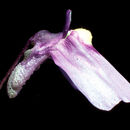fr
noms dans le fil d’Ariane


Utricularia dichotoma, commonly known as fairy aprons,[2] is a variable, perennial species of terrestrial bladderwort. It is a widespread species with mauve or purple fan-shaped flowers on a slender stalk and usually grows in wet locations.
Utricularia dichotoma is a perennial herb with numerous underground trailing stems with bladders 1.5–2 mm (0.059–0.079 in) in diameter. It has absent or a few variable leaves, oval-spathulate 2–4 mm (0.079–0.157 in) long to narrow-lanceolate and up to 40 mm (1.6 in) long. The former is more typical of plants growing in wet soil, the latter of plants growing fully submerged. The inflorescence are borne on a slender, wiry stem 5–50 cm (2.0–19.7 in) long, they are solitary, in pairs or whorls of three or four flowers in clusters near the end of the stem. Each mauve or purple flower has a small upper petal and a broader, semicircular lower lip 1–2 cm (0.39–0.79 in) wide with two or three prominent white or yellow markings, and the corolla is 12–22 mm (0.47–0.87 in) long. Flowering occurs from August to April and the fruit is a globular capsule up to 4 mm (0.16 in) wide.[3][4][5][6]
Utricularia dichotoma was first formally described in 1805 by Jacques Labillardière and the description was published in Novae Hollandiae Plantarum Specimen.[7][8] The specific epithet (dichotoma) is Latin for "dividing into pairs" and refers to the double arrangement of flowers which this species often displays.[9]
Fairy aprons has a large range and is native to New Caledonia, it grows in all states of Australia and in New Zealand on the North Island, South Island and Stewart Island/Rakiura - this being the most southerly location at which a member of this genus occurs. It grows in moist and wet locations.[5][9]
 Habit
Habit Utricularia dichotoma, commonly known as fairy aprons, is a variable, perennial species of terrestrial bladderwort. It is a widespread species with mauve or purple fan-shaped flowers on a slender stalk and usually grows in wet locations.